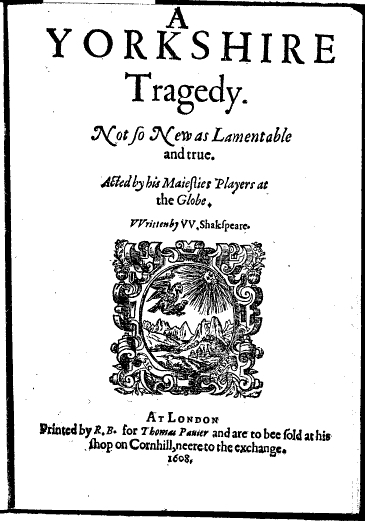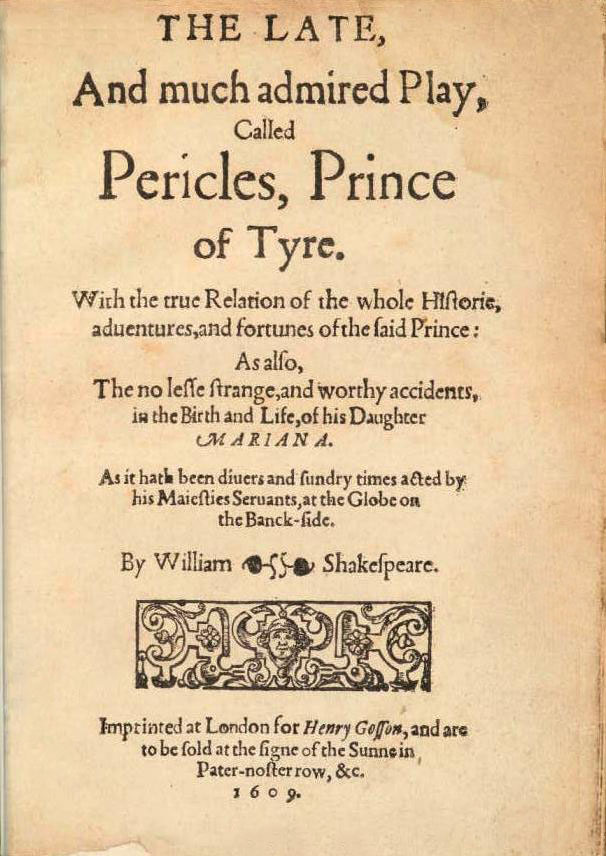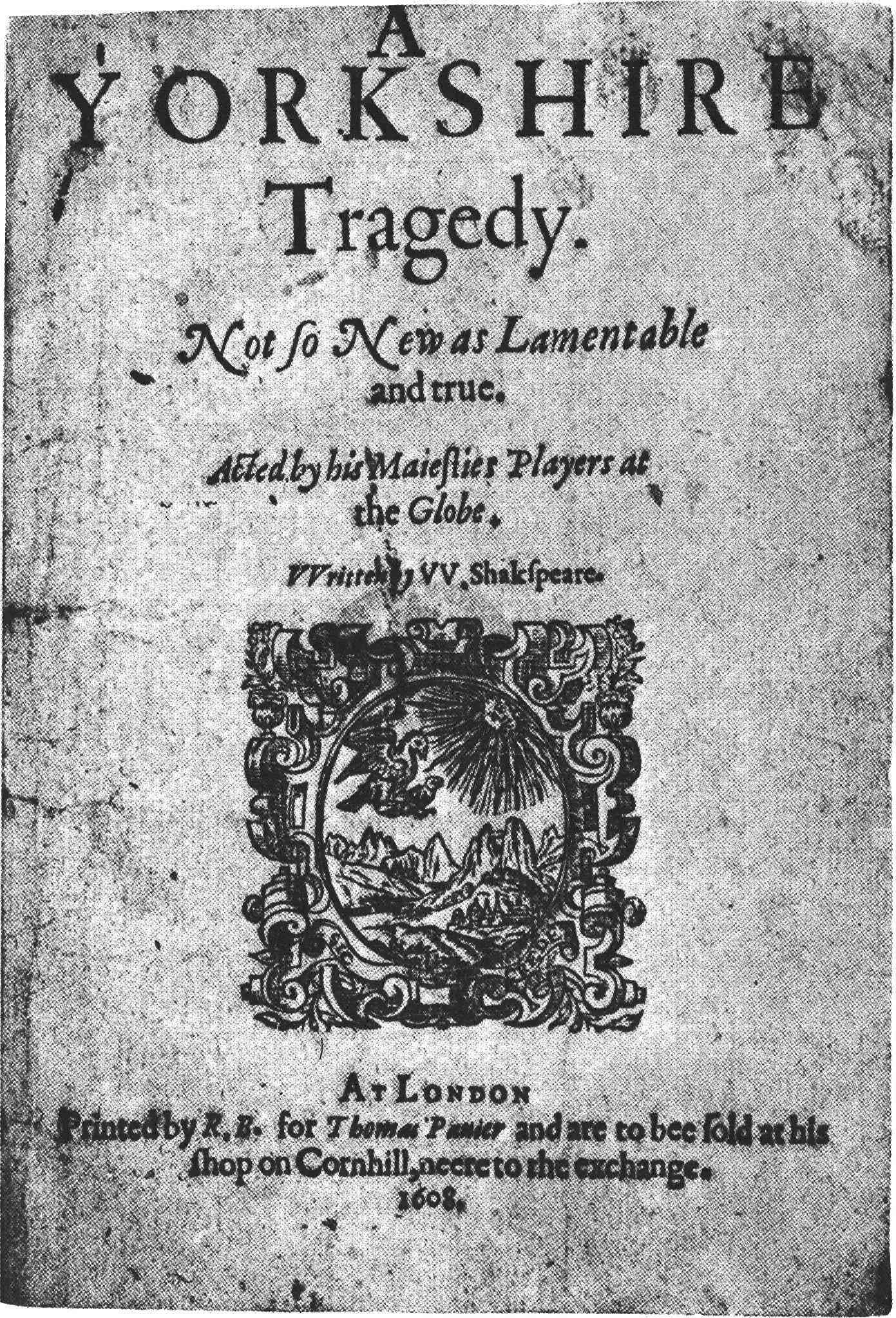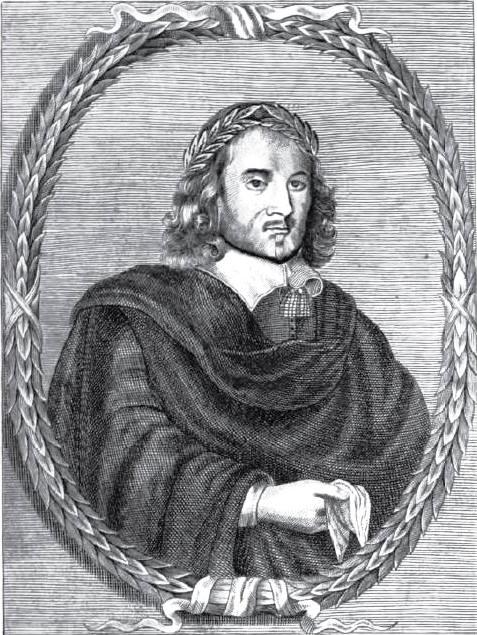|
The Miseries Of Enforced Marriage
''The Miseries of Enforced Marriage'' is a play written by George Wilkins which was published in London in 1607. The play is a fictionalised treatment of the real life case of murderer Walter Calverley whose marriage was an arranged one. It relates the protagonist's descent into debauchery, but the story is modified so that it stops short of the murders he committed in 1605. Wilkins' literary career appears to have been of short duration, but ''The Miseries of Enforced Marriage'' was reprinted, and he was involved in another popular stage work for the King's Men, ''Pericles, Prince of Tyre'' (Wilkins is generally agreed to have been co-author with William Shakespeare). In later life Wilkins was involved in crime. Wilkins had premises in the area around Cow Cross and Turnmill Street, then a notorious red-light district; he claimed to be running a pub, but court records suggest that it was a front for prostitution. Related works Calverley's crimes were the subject of another p ... [...More Info...] [...Related Items...] OR: [Wikipedia] [Google] [Baidu] |
George Wilkins
George Wilkins (died 1618) was an English dramatist and pamphleteer best known for his probable collaboration with William Shakespeare on the play ''Pericles, Prince of Tyre''. By profession he was an inn-keeper, but he was also apparently involved in criminal activities. Life Wilkins was an inn-keeper in Cow-Cross, London, an area that was "notorious as a haunt of whores and thieves".Roger Warren, Gary Taylor, MacDonald Pairman Jackson, ''A reconstructed text of Pericles, Prince of Tyre'', Oxford, Oxford University Press, 2004, pp.6-7. Most biographical information about him derives from his regular appearance in criminal court records for thievery and acts of violence. Many of the charges against him involved violence against women, including kicking a pregnant woman in the belly, and knocking down and stomping another woman. The latter appears in other records as a known "bawd", or keeper of prostitutes. These facts have led to the suggestion that his inn functioned as a br ... [...More Info...] [...Related Items...] OR: [Wikipedia] [Google] [Baidu] |
Walter Calverley
Walter Calverley (c. 1570–1605) was an English squire from Yorkshire. Perhaps the most infamous member of the Calverley family, he is most known for murdering two of his young children, leading to his own execution by pressing in 1605. His story became the basis for more than one literary work from the early 17th century. Early life Walter Calverley was born to Sir William Calverley and Lady Katherine Thorneholme, daughter of Sir John Thorneholme of Haysthorpe, Yorkshire and Lady Anne ( Salvin). The Calverleys were lords of the manors of Calverley and Pudsey, Yorkshire. As eldest son, Walter stood to inherit these manors from his father, Sir William. Sir William was the eldest son of Sir Walter Calverley (1535-15) and Lady Anne ( Danby) - Walter's paternal grandparents. Lady Anne was the daughter of Sir Christopher Danby of Farnerley, (1503-1571) and Lady Elizabeth ( Neville), the daughter of Sir Richard Neville, 2nd Baron Latimer (1468 – 1530) and Lady Anne ( Stafford). ... [...More Info...] [...Related Items...] OR: [Wikipedia] [Google] [Baidu] |
King's Men (playing Company)
The King's Men is the acting company to which William Shakespeare (1564–1616) belonged for most of his career. Formerly known as the Lord Chamberlain's Men during the reign of Queen Elizabeth I, they became the King's Men in 1603 when King James I ascended the throne and became the company's patron. The royal patent of 19 May 1603 which authorised the King's Men company named the following players, in this order: Lawrence Fletcher, William Shakespeare, Richard Burbage, Augustine Phillips, John Heminges, Henry Condell, William Sly, Robert Armin, Richard Cowley, "and the rest of their associates...." The nine cited by name became Grooms of the Chamber. On 15 March 1604, each of the nine men named in the patent was supplied with four and a half yards of red cloth for the coronation procession. Chronologically typed To 1610 In their first winter season, between December 1603 and February 1604 the company performed eight times at Court and eleven times in their second, f ... [...More Info...] [...Related Items...] OR: [Wikipedia] [Google] [Baidu] |
Pericles, Prince Of Tyre
''Pericles, Prince of Tyre'' is a Jacobean play written at least in part by William Shakespeare and included in modern editions of his collected works despite questions over its authorship, as it was not included in the First Folio. It was published in 1609 as a quarto, was not included in Shakespeare's collections of works until the third folio, and the main inspiration for the play was Gower's ''Confessio Amantis''. Various arguments support the theory that Shakespeare was the sole author of the play, notably in DelVecchio and Hammond's Cambridge edition of the play, but modern editors generally agree that Shakespeare was responsible for almost exactly half the play — 827 lines — the main portion after scene 9 that follows the story of Pericles and Marina. Modern textual studies suggest that the first two acts, 835 lines detailing the many voyages of Pericles, were written by a collaborator, who may well have been the victualler, panderer, dramatist and pamphleteer Geo ... [...More Info...] [...Related Items...] OR: [Wikipedia] [Google] [Baidu] |
William Shakespeare
William Shakespeare ( 26 April 1564 – 23 April 1616) was an English playwright, poet and actor. He is widely regarded as the greatest writer in the English language and the world's pre-eminent dramatist. He is often called England's national poet and the "Bard of Avon" (or simply "the Bard"). His extant works, including collaborations, consist of some 39 plays, 154 sonnets, three long narrative poems, and a few other verses, some of uncertain authorship. His plays have been translated into every major living language and are performed more often than those of any other playwright. He remains arguably the most influential writer in the English language, and his works continue to be studied and reinterpreted. Shakespeare was born and raised in Stratford-upon-Avon, Warwickshire. At the age of 18, he married Anne Hathaway, with whom he had three children: Susanna, and twins Hamnet and Judith. Sometime between 1585 and 1592, he began a successful career in London as an a ... [...More Info...] [...Related Items...] OR: [Wikipedia] [Google] [Baidu] |
Cowcross Street
Cowcross Street is a street in London. It runs east–west, from St John Street in the east, to Farringdon Road in the west. Farringdon Station is on the corner of Cowcross Street and Turnmill Street. The Castle is a public house opposite Farringdon Station. Eliza, the wife of Sir John Soane, was born in an earlier building with the same name and purpose on the same site in 1760. The Hope is a late 19th-century Grade II listed public house at 94 Cowcross Street. The Public Monuments and Sculpture Association (PMSA) is based at 70 Cowcross Street. London Lesbian and Gay Centre The London Lesbian and Gay Centre was a lesbian and gay community centre located at 67–69 Cowcross Street, London.''The global emergence of gay and lesbian politics: national imprints of a worldwide movement'', Barry D. Adam, Jan Willem Duyvend ..., London's first non-commercial lesbian and gay community centre, was located at 67-69 Cowcross Street from 1985 to 1991. These offices are now used ... [...More Info...] [...Related Items...] OR: [Wikipedia] [Google] [Baidu] |
Turnmill Street
Turnmill Street is a street in Clerkenwell, London. It runs north–south from Clerkenwell Road in the north, to Cowcross Street in the south. One of the oldest streets in London, it has been variously known as Turnmill and Turnbull Street over its history. During the Elizabethan era, under the name Turnbull Street it became "the most disreputable street in London", notorious as a centre of crime and prostitution.Fran C. Chalfant, ''Ben Jonson's London: A Jacobean Placename Dictionary'', University of Georgia Press, 2008, p.186. Origins It is mentioned in a 14th-century document under the name Trylmyl Street. According to John Stow it took the name "Turnmill" because it was close to the River Fleet, along which a number of mills were placed. The ''Turnmill Brook'' was an early name for the Fleet, or at least the local part of it. The antiquarian John Timbs wrote that, "It was long vulgarly called Turnbull and Trunball Street."Timbs, John, ''London and Westminster'', 1868, vol ... [...More Info...] [...Related Items...] OR: [Wikipedia] [Google] [Baidu] |
A Yorkshire Tragedy
''A Yorkshire Tragedy'' is an early Jacobean era stage play, a domestic tragedy printed in 1608. The play was originally assigned to William Shakespeare, though the modern critical consensus rejects this attribution, favouring Thomas Middleton. Date and text ''A Yorkshire Tragedy'' was entered into the Stationers' Register on 2 May 1608; the entry assigns the play to "Wylliam Shakespere." The play was published soon after, in a quarto issued by bookseller Thomas Pavier, who had published ''Sir John Oldcastle,'' another play of the Shakespeare Apocrypha, in 1600. The play was reprinted in 1619, as part of William Jaggard's False Folio. It was next reprinted in 1664, when Philip Chetwinde included it among the seven plays he added to the second impression of the Shakespeare Third Folio. Form and genre The play is unusual in consisting of only ten scenes. The original printed text of the play identifies it as "ALL'S ONE. OR, One of the foure Plaies in one, called a York-Shi ... [...More Info...] [...Related Items...] OR: [Wikipedia] [Google] [Baidu] |
Thomas Middleton
Thomas Middleton (baptised 18 April 1580 – July 1627; also spelt ''Midleton'') was an English Jacobean playwright and poet. He, with John Fletcher and Ben Jonson, was among the most successful and prolific of playwrights at work in the Jacobean period, and among the few to gain equal success in comedy and tragedy. He was also a prolific writer of masques and pageants. Life Middleton was born in London and baptised on 18 April 1580. He was the son of a bricklayer, who had raised himself to the status of a gentleman and owned property adjoining the Curtain Theatre in Shoreditch. Middleton was five when his father died and his mother's subsequent remarriage dissolved into a 15-year battle over the inheritance of Thomas and his younger sister – an experience that informed him about the legal system and may have incited his repeated satire against the legal profession. Middleton attended The Queen's College, Oxford, matriculating in 1598, but he did not graduate. Before he ... [...More Info...] [...Related Items...] OR: [Wikipedia] [Google] [Baidu] |
Aphra Behn
Aphra Behn (; bapt. 14 December 1640 – 16 April 1689) was an English playwright, poet, prose writer and translator from the Restoration era. As one of the first English women to earn her living by her writing, she broke cultural barriers and served as a literary role model for later generations of women authors. Rising from obscurity, she came to the notice of Charles II, who employed her as a spy in Antwerp. Upon her return to London and a probable brief stay in debtors' prison, she began writing for the stage. She belonged to a coterie of poets and famous libertines such as John Wilmot, Lord Rochester. Behn wrote under the pastoral pseudonym Astrea. During the turbulent political times of the Exclusion Crisis, she wrote an epilogue and prologue that brought her into legal trouble; she thereafter devoted most of her writing to prose genres and translations. A staunch supporter of the Stuart line, she declined an invitation from Bishop Burnet to write a welcoming ... [...More Info...] [...Related Items...] OR: [Wikipedia] [Google] [Baidu] |
The Town Fop Or, Sir Timothy Tawdry
''The Town-Fopp: or, Sir Timothy Tawdrey'' is a Restoration comedy written by Aphra Behn and first staged in 1676. It deals with an unhappy marriage and its dissolution. The play reworks George Wilkins' play ''The Miseries of Enforced Marriage'' (1607), itself based on events from the life of Walter Calverley who entered into an arranged marriage. A heavy drinker, Calverley stabbed his wife and killed two of his children in 1605, but these crimes are not related in Wilkins' play which contrives a happy ending. In Behn's play the unhappy couple manage to dissolve their marriage and seek happiness with other partners. Plot Bellmour is in love with Celinda, and they are secretly betrothed. However, Celinda's parents intend her to marry Sir Timothy Tawdrey, a fop. Lord Plotwell, who is Bellmour's uncle and guardian, forces him to marry Diana. Bellmour refuses to consummate his marriage to Diana, and tells her that he cannot love her. An angry Diana tries to seduce Celinda (whilst ... [...More Info...] [...Related Items...] OR: [Wikipedia] [Google] [Baidu] |








